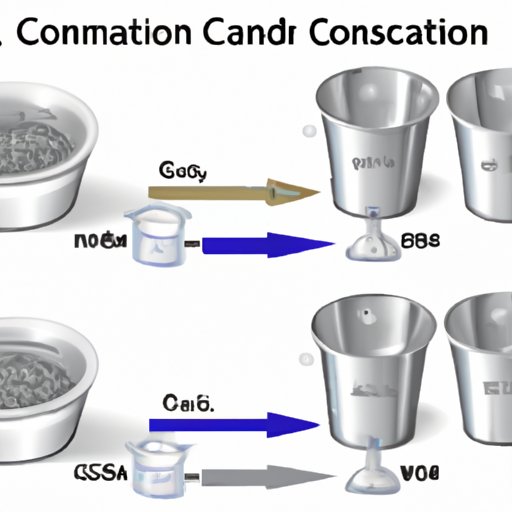I. Introduction
Converting between different units of measurement can be a difficult task, especially when it comes to grams and millilitres. As we encounter these two units often in various settings, it is important to have a comprehensive understanding of how they relate to each other. This article will provide you with a beginner’s guide to understanding how many grams are in a millilitre and why it matters.
II. Understanding the Relationship Between Grams and Millilitres
Grams and millilitres are both units of measurement that help us quantify different physical properties of a substance. Grams are used to measure the amount of mass of a substance, while millilitres are used to measure the volume of a substance.
Converting between the two units is necessary when measuring substances that have different densities. For instance, a cup of sugar will weigh more than a cup of flour even though both occupy the same volume. Therefore, it is essential to have a clear understanding of the relationship between grams and millilitres.
Many people believe that there is a one-to-one ratio between grams and millilitres, but this is not always the case. This misconception often leads to inaccurate measurements when using the wrong units.
III. How to Convert Grams to Millilitres: A Beginner’s Guide
The conversion process from grams to millilitres varies depending on the substance being measured. Here’s a simple guide to getting started:
- Determine the density of the substance in question. This can be found online or in a reference book.
- Divide the mass (in grams) of the substance by its density (in g/ml). The resulting number will be the volume of the substance in millilitres.
- Use the appropriate measuring tool (such as a graduated cylinder) to measure the volume of the substance in millilitres.
For example, let’s say you want to convert 50 grams of olive oil to millilitres. The density of olive oil is about 0.92 g/ml. So, by dividing 50 grams by 0.92 g/ml, you get a volume of 54.3 ml.
IV. The Science Behind the Ratio of Grams to Millilitres
The concept of density plays a vital role in understanding the relationship between grams and millilitres. Density is defined as the amount of mass per unit volume of a substance. Different substances have different densities, which means that they have different ratios of grams to millilitres.
For instance, water has a density of 1 g/ml, which means that 1 millilitre of water weighs 1 gram. Other substances have different densities, such as olive oil with a density of 0.92 g/ml or honey with a density of 1.42 g/ml.
Understanding the concept of density and how it relates to grams and millilitres is crucial for accurate measurements, especially when dealing with substances of varying density.
V. Converting Units: How Many Grams are in a Millilitre?
The answer to how many grams are in a millilitre depends on the substance being measured. As previously mentioned, each substance has a unique density that affects the ratio of grams to millilitres.
For example, the density of water is 1 g/ml, which means that 1 millilitre of water weighs 1 gram. On the other hand, the density of olive oil is 0.92 g/ml, which means that it takes 1.09 ml of olive oil to make 1 gram.
Here are a few examples of the ratios of grams to millilitres for common substances:
- Water: 1 gram = 1 millilitre
- Milk: 1 gram = 1.03 millilitres
- Honey: 1 gram = 1.42 millilitres
- Olive Oil: 1 gram = 0.92 millilitres
VI. Exploring the Importance of Accurately Measuring Grams and Millilitres
Measuring the right amount of a substance is crucial in many settings. For example, when cooking or baking, using the wrong amount of an ingredient can lead to disastrous results. In laboratory settings, inaccurate measurements can compromise experimental results and lead to incorrect conclusions.
It is essential to be aware of the potential consequences of inaccurate measurements and take measures to ensure precise measurements at all times.
VII. Breaking Down the Basics: Grams vs Millilitres
Here’s a quick reference guide for converting between grams and millilitres:
- To convert grams to millilitres, divide the mass (in grams) by the density (in g/ml).
- To convert millilitres to grams, multiply the volume (in ml) by the density (in g/ml).
For more information on the densities of different substances, reference books and online resources can be helpful tools.
VIII. Mastering the Art of Converting between Grams and Millilitres
Converting between grams and millilitres can be a daunting task, but practice makes perfect. Here are a few tips to help you master the conversion process:
- Keep a reference book or an online resource on hand for quick access to density values.
- Double-check your calculations to avoid mistakes. Using a calculator or spreadsheet program can be helpful in ensuring accuracy.
- Practice measuring different substances with different densities to become more familiar with the conversion process.
Remember, accurate measurements are crucial in many settings, so take the extra time to ensure that your conversions are precise.
